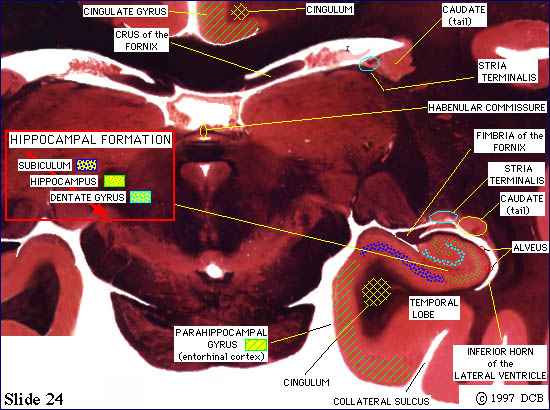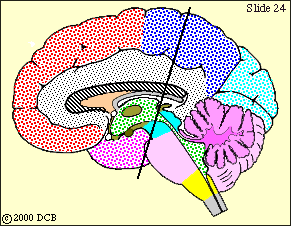LIMBIC SYSTEM - THE HIPPOCAMPUS


x- PIXBRAIN HOME _ _ MOD 13 HOME _ _ I WANT TO -x
TRIP 2 #1 - While the amygdala is a nucleus, buried within the temporal lobe, the hippocampus is - in fact - the rolled-up medial edge of the temporal lobe cortex. Blumenfeld Fig. 18.7 shows this well. Because of the important role the hippocampus plays in the laying down of new memories the neuronal interactions within this structure have been studied intensivily. In part, this has been possible because of the 3 layered structure of this "primitive" cortical region. So, you need to become familiar with the terms within the red box above, and you should to be able to identify
each of them on a section through the hippocampus. Beyond that,you ought to master the terms and the neural pathway diagrammed in Old Fig. 20. This will seem like an onerous level of detail, but you will need it to understand the studies of long term potentiation discussed on Pg. 776-7 in Blumenfeld.
_____Before we start our trip, use the "1 rostral" and "1 caudal" buttons to see what the hippocampus looks like a sections rostral and caudal to this one, BUT RETURN HERE, TO SLIDE 24, TO START THE TRIP.
_____ Next, we suggest you call up FIGURE 13-1 and FIGURE 13-2 and keep them handy. Our starting point (this slide) is shown by line C in Fig 13-1 and our goal is to trace out the Papez circuit, described in Old Fig 11. Since the stria terminalis (the second output pathway of the amygdala) runs near the fornix, we will trace it as well. Look at Blumenfeld Fig. 18.13 for the geometry of the fornix and the names of the various parts of this structure.
_____Finally, note that both the fornix and the stria terminalis have been cut twice in this section, and confirm why this has happened by looking at Figure 13-1. Now, we will look at two, more caudal, sections, to see how things come together. NEXT